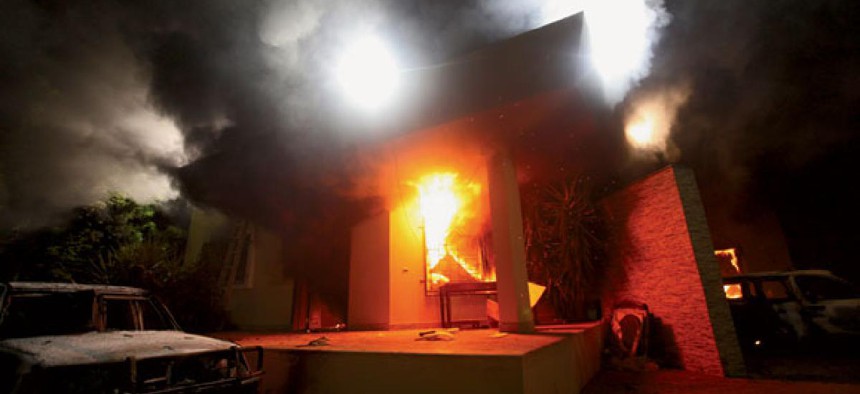
State eyes a system to track diplomats in case of attack. Landov
Tracking Diplomats
The agency charged with securing U.S. embassies plans to purchase a system that could locate and track diplomats during an emergency based on the signals beaming from their satellite and cellphones, documents show. That system could be extremely effective at monitoring security during an embassy or consulate attack, but also could expose diplomats to new dangers if the system were hacked.
The personnel tracking locator system would replace nine-year-old technology that the State Department’s Diplomatic Security Service uses to pinpoint the location of employees both at embassies and domestically. It’s not clear whether the existing personnel tracker played any role in the State Department response to the Sept. 11 attack in Benghazi, Libya, that killed Ambassador J. Christopher Stevens and three other diplomats. The department declined to answer questions about the current tracking system or its proposed replacement.
“What’s dangerous about this is that these systems can be hacked so they could basically be beaconing [diplomats’] positions,” says Tom Kellermann, vice president of cybersecurity at Trend Micro, a company that develops antivirus software.
“There’s a phenomenon all through the U.S. government where physical and personal security folks adopt technology to provide more kinetic security and, in fact, they open up an entirely new can of worms,” Kellerman adds.
DSS is responsible for securing embassies from attack and for protecting certain State Department officials traveling abroad. The service also is responsible for guarding some foreign dignitaries traveling in the United States.
- Joseph Marks
Stormy Forecast
The Obama administration’s plan to share weather satellite frequencies with commercial cellular carriers could degrade scientists’ ability to forecast hurricanes and monitor flooding, weather and spectrum, experts told Nextgov.
The Federal Communications Commission proposed reallocating spectrum used by weather satellites in the 1675-1710 MHz band for commercial use in its 2010 National Broadband plan, a shift widely opposed by weather organizations worldwide. FCC and the National Telecommunications and Information Administration in August narrowed the portion of spectrum up for grabs to the 1695-1710 MHz band and endorsed sharing it with commercial users.
John Snow, professor of meteorology at the University of Oklahoma, says this plan could interfere with the reception of data from satellite sounding instruments that measure atmospheric temperatures, cloud cover, moisture and humidity. Weather satellite instruments play a key role in assessing conditions over oceans—where hurricanes form—because forecasters do not have other means of measuring key parameters as they do over land, Snow says.
- Bob Brewin
Cyber Safeguards
U.S. and foreign government officials, along with antivirus companies and banks, have formed a coalition to push for adoption of electronic safeguards that could help them avoid data breach lawsuits.
Led by a veteran of the National Security Agency, the Consortium for Cybersecurity Action is proposing a set of 20 security controls for immunizing computer systems.
“This is about priority,” said Tony Sager, who in June retired from NSA. The 20 steps are “the most important defenses that every firm should put in place that are of greatest value.”
- Aliya Sternstein
Demonstrating Telework’s Value
While much of the federal workforce in Washington took Oct. 29 to 30 off when Hurricane Sandy pounded the East Coast, 2,000 employees at the Defense Information Systems Agency—roughly 40 percent of DISA workers—continued to work from home thanks to a well-developed telecommuting plan put in place more than five years ago.
DISA spokesman Steven Doub said employees who are authorized to telework were instructed to take their laptops home the weekend prior to the storm as a precautionary measure so they could take unscheduled telework as needed.
Although some Washington-area federal workers probably lacked power and Internet service and had to deal with storm damage, Sandy makes a good argument for having a governmentwide telework infrastructure.
- Bob Brewin
NEXT STORY: Tech Roundup






